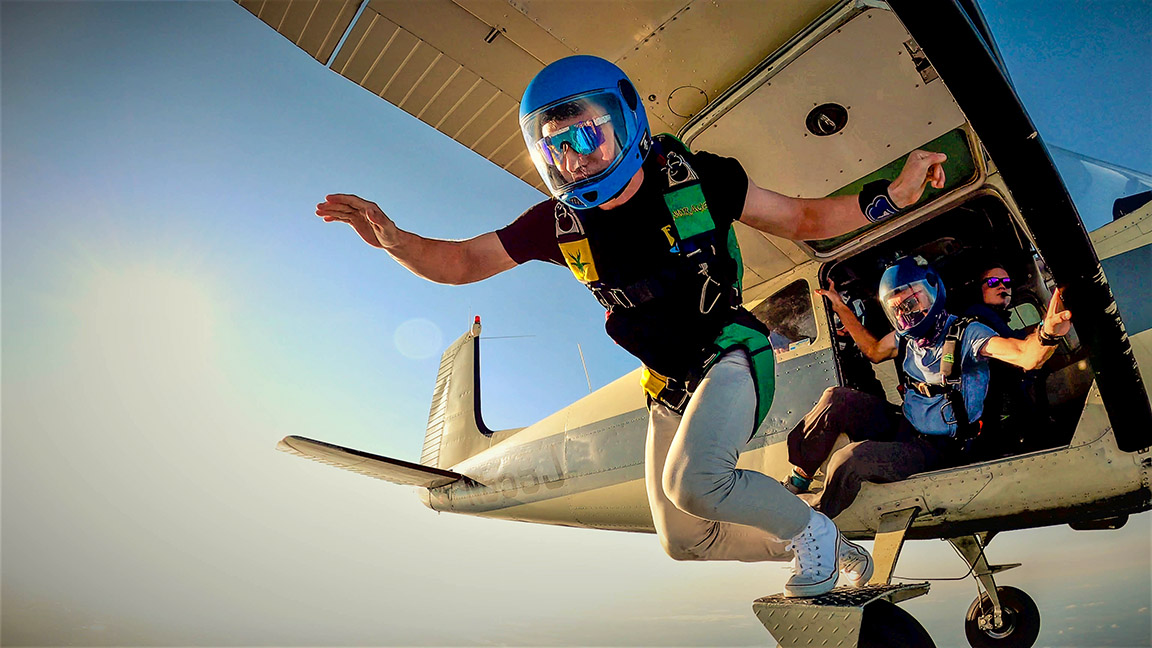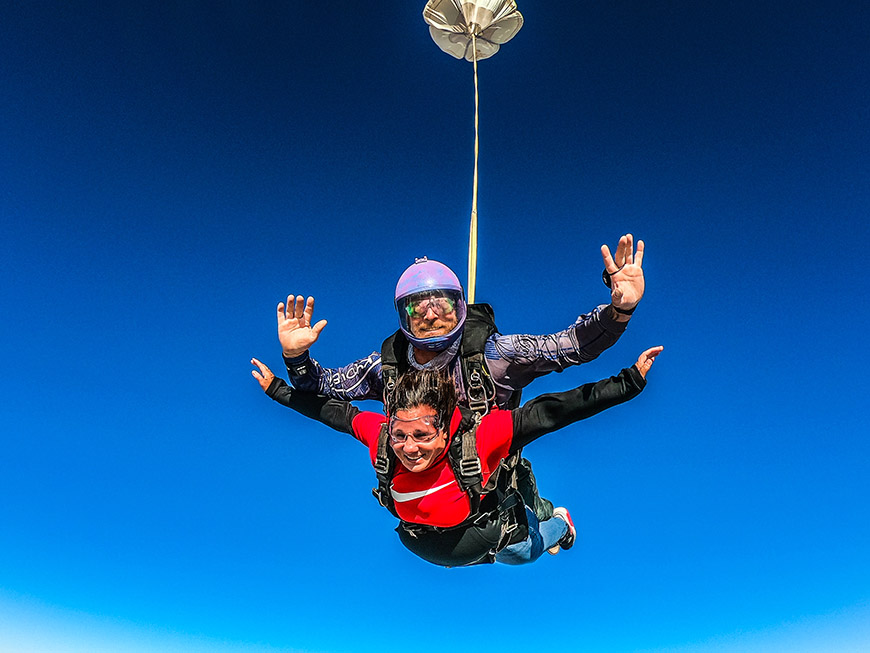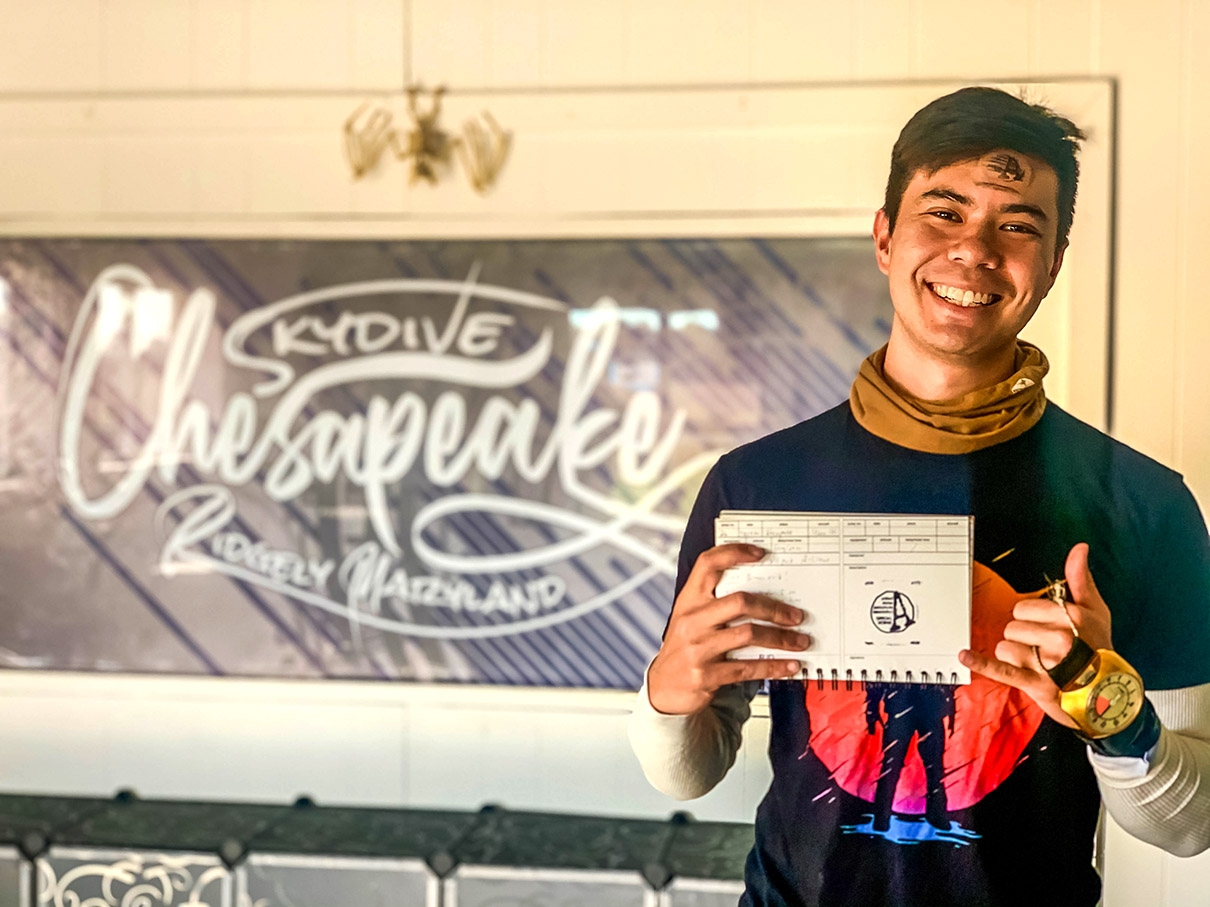Chris Derbak, Max Sivohins and Ben Harris provide Instagram moments of a lifetime at Skydive Chesapeake
Written by Katie Riley | Photography courtesy Skydive Chesapeake
Twelve-thousand feet above sea level on Maryland’s Eastern Shore, it’s just another day at the office for Chris Derbak. The military veteran and owner of Skydive Chesapeake is gearing up for his 8,000th jump. Derbak checks his harness one last time as the pilot levels out the airplane.
The doors open, and Derbak drops into freefall for another 7,000 feet before pulling his parachute cord, floating above a patchwork landscape that stretches as far as the Atlantic Ocean.
It’s a feeling that never gets old.
“I’ve jumped in 49 states and have been doing this for more than 20 years. Every time feels like the first time,” said Derbak.
Every year, more than half a million people will jump out of an airplane for the first time. Novice skydivers and first-time jumpers must skydive in tandem or strapped to an instructor who will guide them during the jump. At Skydive Chesapeake in Ridgely, tandem jumps are offered several days per week from their fleet of Cessna-182s or from their larger Piper Navajo eight-passenger plane. Skydive Chesapeake is also the only company in the area that offers solo jumps for licensed skydivers.
Formerly known as Skydive Delmarva, Skydive Chesapeake is a legacy business owned by Chris Derbak, Max Sivohins and Ben Harris. All three are professional skydivers with years of experience. Derbak, a licensed commercial pilot, and Sivohins are veterans of the U.S. Coast Guard and the Air Force, respectively. Harris is a professional parachute rigger who designs parachutes for major manufacturing companies. Their combined expertise attracts a loyal following among locals, military vets and tourists alike.


“People try it for a lot of different reasons,” Derbak says. “The younger generations tend to do it for the Instagram moment, but many clients are going through a transitional period in life and want an extraordinary feeling or sense of accomplishment after a hard time in their lives.”
Indeed, Derbak says skydiving is an experience that is especially appealing to those in addiction recovery, noting that it’s a healthy way to get an adrenaline rush. The company also works closely with veterans and founded a nonprofit organization, Jump for Valor, which works with combat, retired and disabled veterans dealing with PTSD (see sidebar).
Skydivers must be over the age of 18 and in good health but aren’t required to have any experience or athletic qualifications. Derbak has even jumped with a customer on her 100th birthday. For many, it’s a one-time bucket-list experience. Despite this, nearly 70% of divers at Skydive Chesapeake are repeat customers.
A typical tandem skydive starts on the ground, with a safety lesson in the hangar. Divers are then fitted with a jumpsuit and harness and paired with an instructor who will accompany them on the tandem skydive. Before boarding the plane, instructors conduct more safety checks on the equipment and answer any final questions before the flight.
“As an instructor, your job is to protect this human life. It is something we take with the utmost seriousness,” Derbak says, noting that their entire staff is ex-military and highly trained for every possible scenario.


“People try it for a lot of different reasons. The younger generations tend to do it for the Instagram moment, but many clients are going through a transitional period in life and want an extraordinary feeling or sense of accomplishment after a hard time in their lives.”
— Chris Derbak, Skydive Chesapeake

According to the United States Parachute Association, skydiving is one of the safest sports in existence. In the past decade, there has only been one fatality per 500,000 tandem skydiving jumps, making it more likely that a person could die from being struck by lightning than from a skydiving accident.
“Accidents are more likely to happen with experienced skydivers pushing their limits; it’s the sad reality of the sport,” Derbak says.
After takeoff, the plane will ascend to 12,000 feet before leveling out. The plane hovers in a precise location, assuring that divers land in the airfield where they took off. When the plane doors open, there is no turning back. Derbak says that most first-time skydivers imagine the initial freefall to be traumatic but says that it is a rushing feeling that transforms into a peaceful, floating sensation once the parachute cord is pulled.
“You are as close to being a bird as Mother Nature could have ever created.”
For more information, visit SkydiveChesapeake.com.
Jump for Valor
Founded in 2019 by Chris Derbak, a retired Air Force and U.S. Coast Guard veteran, Jump for Valor is a charitable nonprofit organization dedicated to helping veterans through skydiving and aerial sports. With a board of directors comprising retired and active-duty military personnel, Jump for Valor provides training and education for disabled veterans or those dealing with post-traumatic stress disorder (PTSD).
“Our mission is to help transitioning veterans find a community of support, recreation and a sense of pride or accomplishment,” says Derbak. “After completing a skydive, one can often have a sense of ‘If I can do this, I can do anything.’”
Skydiving has therapeutic effects, including providing a healthy adrenaline rush and a sharpened focus. Completing an accelerated freefall (AFF) certification can help a disabled veteran face fears and gain more control of their situational awareness. Jump for Valor has also helped physically disabled veterans gain confidence as they progress through the rehabilitation process.
Funded through private donations and sponsorships, Jump for Valor hosts several annual events held nationally each year that are free for qualified veterans. Its next event, during Memorial Day weekend 2021, will be held in Raeford, NC, near Fort Bragg.
For more information or to donate, visit jump4valor.org.
